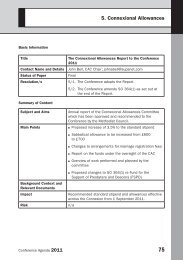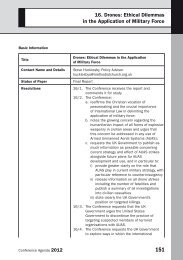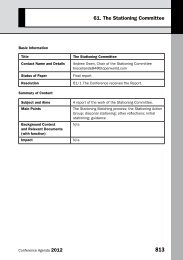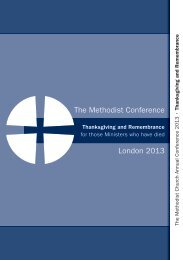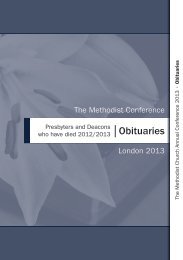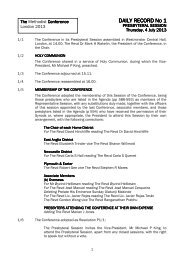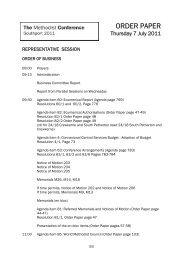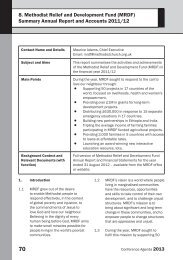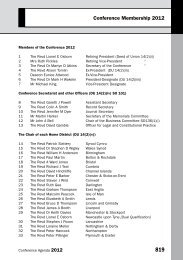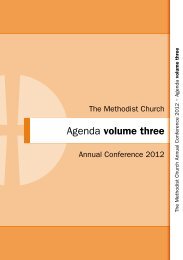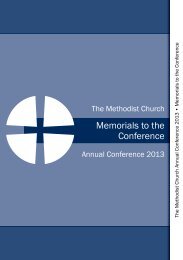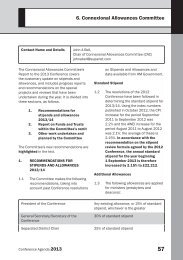Agenda Volume 2 - Methodist Conference
Agenda Volume 2 - Methodist Conference
Agenda Volume 2 - Methodist Conference
Create successful ePaper yourself
Turn your PDF publications into a flip-book with our unique Google optimized e-Paper software.
35. Larger than Circuit<br />
11. If we then turn to a consideration of<br />
our foundational rules, as expressed<br />
in the Deed of Union and the<br />
Standing Orders based upon them,<br />
we see that they both inform and are<br />
informed by this description of our<br />
self-understanding as a church.<br />
12. It should be stressed at the outset<br />
that in this section districts are<br />
considered, not primarily from the<br />
angle of ‘life as we know it’ but from<br />
the constitutional perspective: what<br />
provisions appear in the rules?<br />
What would need to be changed<br />
or removed if there was a different<br />
pattern? It should also be stressed<br />
that there is no provision here<br />
which could not legally be changed<br />
(although any changes to the Deed<br />
of Union would require the ‘special<br />
resolution’ procedure 6 ).<br />
The development of districts<br />
13. The grouping of circuits into<br />
districts with Chairmen dates from<br />
the period immediately after John<br />
Wesley’s death. The development<br />
was intended to provide a means<br />
for dealing with problems, disputes<br />
and disciplinary matters, and for<br />
offering support and advice to the<br />
Circuit Assistants [Superintendents]<br />
between meetings of the<br />
<strong>Conference</strong>. Gradually the ‘District<br />
Committee’ or ‘District Meeting’<br />
[later, Synod], became a significant<br />
6. ie a 75% majority at two successive <strong>Conference</strong>s,<br />
with appropriate consultation (no doubt with the<br />
districts) during the intervening year.<br />
part of connexional life. Organisation<br />
into districts continued into the<br />
various <strong>Methodist</strong> traditions and<br />
at <strong>Methodist</strong> Union in 1932 the<br />
connexion consisted of 46 districts<br />
in the home work and 36 overseas.<br />
14. A later review of the role of District<br />
Chairman [now Chair], with increased<br />
emphasis on their being a ‘District<br />
Missioner’ as well as pastor to the<br />
ministers, led to the decision that<br />
in most cases they needed to be<br />
‘separated’, ie not to hold a circuit<br />
appointment. To enable this to be<br />
afforded, in 1957 the number of<br />
home districts was reduced to 34,<br />
on the basis of roughly 30,000<br />
members per separated Chairman.<br />
15. There are now 31 home (and no<br />
overseas) districts, many with largely<br />
the same configuration as in 1957.<br />
All but four have separated Chairs.<br />
Three of those four operate as single<br />
circuit districts.<br />
16. Since 2006, co-Chairs can be<br />
appointed; currently London has<br />
three. Also in 2006, the possibility<br />
of appointing a permanent deputy<br />
Chair for a district was put on a more<br />
formal basis, together with provisions<br />
for appointing temporary deputies<br />
and assistants to Chairs (SO 426). A<br />
range of patterns of leadership has<br />
therefore emerged.<br />
The basis and purpose of districts<br />
17. Do we currently have to have<br />
districts? Yes, we do. Clause 38 of<br />
372<br />
<strong>Conference</strong> <strong>Agenda</strong> 2013



